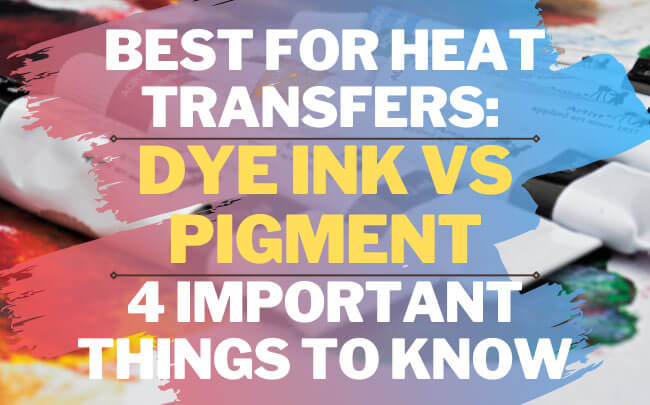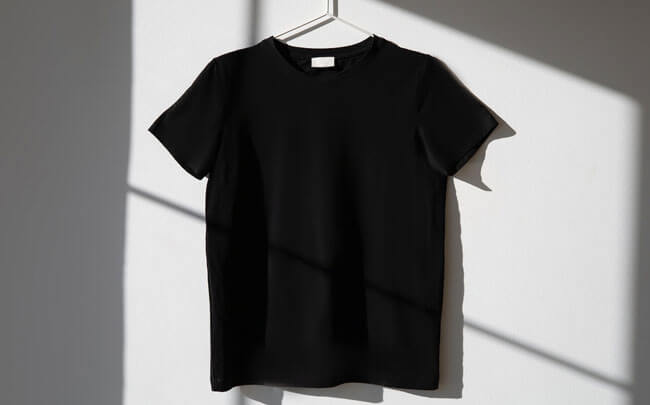
Printing on fabric using heat transfers can be extremely rewarding and a lot of fun. But before we get to that stage of excitement, things will be quite confusing as you start.
I wish it was as simple as nailing down an ink type, but it isn’t. The most challenging part in my opinion, is finding the perfect combo between the type of printer, fabric and transfer paper that matches with your chosen ink.
Overwhelmed yet? Don’t worry because once you’re done reading this article, everything will be crystal clear.
So let’s start with the basics.
As you already know there are two types of ink used for heat transfers – dye ink vs pigment. Each is unique in its own way, and has properties and advantages that fit your needs.
Let’s start off with pigment ink.
Pigmented ink is actually made up of ultra-fine colored particles that float around in liquid. It is waterproof and doesn’t dissolve, which makes the ink really thick and easy to see. On the other hand, dye ink is the opposite. It is water soluble meaning it dissolves in liquid. It’s like pouring concentrated grape juice into water – it disperses and forms a uniform mixture.
Now that you understand the basic characters of both ink, let’s go over a few key differences to keep in mind for your next heat transfer project.
1. Lifespan and color

Dye ink is great for producing brilliant, bright, vibrant colors that really pop. However, it doesn’t hold up as well over time and colors can/will start to fade and lose their intensity, especially if they are exposed to repeated washing and sunlight.
Pigment ink however, has more muted tones and isn’t as bright or vibrant compared to dye but is more durable and resistant to water, light, and heat. Plus, it’s quite versatile and can be used with different types of transfer papers. If you plan to do a lot of commercial printing, investing in pigment ink is the way to go.
Major differences between dye ink vs pigment
Dye Ink Pros |
Pigment Ink Pros |
|---|---|
|
|
Dye Ink Cons |
Pigment Ink Cons |
|
|
2. Using the right printer
Most printers on the market use dye-based inks due to their cost-effectiveness, as pigment-based inks tend to be more expensive. Keep this in mind and do not make the mistake of using pigment inks in a dye-based printer.
As you already know pigment inks contain solid particles and this can cause clogging and blockages to the printer nozzles of a dye-based machine.
Even if you are using pigment inks for a pigment-based printer, it’s important to use compatible inks to ensure the highest print quality. Since cost is a factor, I’ve known some people who have bought aftermarket or third-party pigment inks that have completely destroyed their printer heads. If you’re thinking about this route, just make sure to buy directly from a reputable source.
Until today, Epson has the widest selection of pigment based printers like the popular EcoTank ET-2800. And after speaking to several industry vets, most prefer it over other brands.
Many swear by their pigment inks and also for their ink jet printer head technology – Epson uses micro-piezo print heads while Canon (most models) and HP uses thermal (heat) print heads.
3. Paper type
Let’s get one thing straight. Heat transfer paper matters, and it can vary in terms of quality and ink absorption. Using dye inks with the right paper type will give you vibrant prints that will outmatch pigment ink.
However, you can’t argue with science.
Dye inks will always be water soluble while pigment ink is waterproof. So even though dye inks may image better initially, their integrity will fade over time, regardless of paper type.
If you are printing and selling t-shirts, go with pigment ink with the right paper. You do not want customers coming back to you with fading or bleeding artwork issues. Neenah’s Jet-Pro for lights and 3G Opaque for darks have been a favorite amongst many for years.
4. Blanks

It all comes full cycle when you think about it. Ink is printed on paper which is then transferred onto a blank t-shirt, so it’s equally important to consider the material you’ll be pressing on.
From 100% cotton to polyester and all the blends in between, not all fabrics are created the same. Here’s a breakdown of the four most popular t-shirt fabrics, and which are the best ones for your project.
100% Cotton
- most common fabric for T-shirts
- soft, breathable fabric, and natural
- hypoallergenic – a huge plus for someone who gets itchy or rashy
100% Polyester
- synthetic fabric that keeps its shape – no shrinkage
- hydrophobic, or “moisture-wicking” allowing it to dry quickly
- typically used for athletic and outdoor clothing
- odor-resistant and doesn’t stain as easily
Cotton-poly blends
- typically 50/50 or 60/40 cotton-polyester combination
- blend between cotton’s softness and natural feel with polyester’s hydrophobic and anti-odor properties
- durable, shrink and wrinkle free
Tri-Blends
- combination of polyester, cotton, and rayon (50/25/25)
- the best of all three worlds – super soft, highly breathable, durable, and flexible
- anti-odor and hypoallergenic
Verdict
Between all four, tri-blends have become one of the most popular fabrics in the T-shirt industry simply because it has the best combo. It’s super soft, lightweight, and feels like a cloud is hugging you.
However, because of how light they are, not all print methods are suitable as it will weigh down the fabric. Heat transfers without a ‘soft’ hand will do this, so keep this in mind. Choose to do a test or have a manufacturer show you samples first before going through with it.
If you intend to print up tees for retail or for merch, your best bet will either be 100% cotton or polyester, depending on your customer’s preference. I would put a caution on cotton/poly blends for the same reason as tri-blends, although I’ve personally gotten excellent results with 50/50 blends.
READ: Can you screen print on polyester garments?
So which ink is best for t-shirt printing?
Now that we’ve looked at all the differences between dye ink vs pigment, the best choice for heat press printing garments is obviously, pigment ink. While dye ink is affordable and produces vibrant colors, pigment ink is more durable and versatile, making it the preferred choice for commercial printing and dark-colored fabrics.
And when you’ve successfully matched the ink with the correct printer and heat transfer paper, it can make a big difference in the quality and longevity of your prints. Good luck on your projects ahead!
